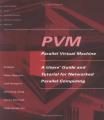
Parallel Complexity Theory
by Ian Parberry
Publisher: Prentice Hall 1987
ISBN/ASIN: 0273087835
ISBN-13: 9780273087830
Number of pages: 212
Description:
Parallel complexity theory is one of the fastest-growing fields in theoretical computer science. This rapid growth has led to a proliferation of parallel machine models and theoretical frameworks. This book presents a unified theory of parallel computation based on a network model.
Download or read it online for free here:
Download link
(8.6MB, PDF)
Similar books
 PVM: Parallel Virtual Machine
PVM: Parallel Virtual Machineby Al Geist, at al. - The MIT Press
Written by the team that developed the software, this tutorial is the definitive resource for scientists, engineers, and other computer users who want to use PVM to increase the flexibility and power of their high-performance computing resources.
(12103 views)
 Distributed Detection and Estimation in Wireless Sensor Networks
Distributed Detection and Estimation in Wireless Sensor Networksby Sergio Barbarossa, Stefania Sardellitti, Paolo Di Lorenzo - arXiv
We consider the problems of distributed detection and estimation in wireless sensor networks. We provide a general framework aimed to show how an efficient design of a sensor network requires a joint organization of in-network communication.
(7798 views)
 An introduction to one-way quantum computing in distributed architectures
An introduction to one-way quantum computing in distributed architecturesby Earl T. Campbell, Joseph Fitzsimons - arXiv
This review provides a gentle introduction to one-way quantum computing in distributed architectures. One-way quantum computation shows significant promise as a model for distributed systems, particularly probabilistic entangling operations.
(9585 views)
 A Framework for Enabling Distributed Applications on the Internet
A Framework for Enabling Distributed Applications on the Internetby Mark Anthony McLaughlin - arXiv
Internet distributed applications (IDAs) are internet applications with which many users interact simultaneously. In this paper the author provides a basis for a framework that combines IDAs collectively within a single context.
(8716 views)